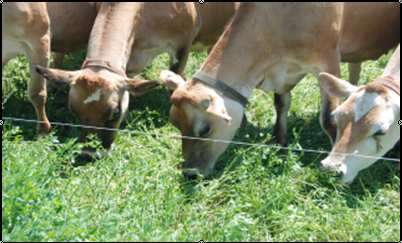Manage Your Grazing System for Optimum Dairy Cow Performance
Manage Your Grazing System for Optimum Dairy Cow Performance
Allowing dairy cows to graze forages versus harvesting and storing them can be an economical way to provide some or all of a dairy cows’ forage needs. Grazed forages can provide as little as 15% of the forage needs of dairy cows or up to the majority of the forage component of their diets. The amount of grazed forage consumed can vary with growing conditions and/or the time of year.
Grazing forages for the milking dairy herd is nothing new. It has been practiced for years, but what has changed over time are some of the forage management practices. Today, we pay more attention to the forage species in the pasture fields, try extra hard to graze young, vegetative plants for higher quality forages through managing the rotation of fields or paddocks using temporary fencing, and making sure water is always close to the cows (within 800 ft). One of the biggest realizations is that pasture systems must be managed closely and the movement of the cows must constantly evolve and change to match the availability of forages. Outlined in this article are some of the key components in managing a grazing system for the milking dairy herd.

1) Manage the forage rotation to allow the forage plants time to rest and regrow. In the summertime, rest periods need to be approximately 28 to 35 days between grazing periods. Grasses regrow from the tillers that are close to the soil surface, thus it is important for 3 to 4 inches of growth to remain after grazing orchardgrass or fescue plants. Closer grazing increases the time of regrowth, decreases survivability of the plants especially during drought conditions and decreases the nutrition provided to the dairy cow. In contrast to grasses, alfalfa and red clover plants regrow from the carbohydrate stores in the plant’s roots thus a lower residual grazing height is possible. In stands that you want to favor the growth of the legumes, the stand is grazed lower. If you want to favor the growth of the grasses, graze the plants higher.
2) Graze young lush plants in their vegetative state. Vegetative plants contain more nutrients, such as carbohydrates, starches and sugars, for energy and protein that cattle can use for their nutrition. More mature plants have more lignin and are less digestible in the rumen. This results in forages “staying in the rumen longer” which in turn decreases intake and decreases milk production.
3) Dairy cows graze about 8 hours daily with the heaviest grazing periods in the early morning and later in the evening. Dairy cows do selectively graze forage types. In addition, the first bite of forage is from the top of the plant containing the highest concentration of nutrients. The next bite is the middle of the plant where the nutrition is somewhat less than the top. The lower part of plants contains more stem and thus fiber than the upper parts of both legume and grass plants. Requiring animals to consume most of the plant in a single grazing pass results in more even consumption of nutrients found in the plant. Strip grazing using temporary fencing allows one to achieve this objective. Remember with dairy cows we want to take half of the available forage and leave half behind.
4) Like any feeding system, maintaining dry matter intake in dairy cows is important. Dry matter intake on grazed forages is determined by bite rate, time spent grazing, and the bite size. Cattle usually are capable of 50 to 70 bites of forage per minute, spend up to approximately 8 hours daily grazing, and average a bite size of 0.2 ounces per bite. Bite size is the most variable of these three factors that determine dry matter intake from grazed forages. Bite size is directly related to stand density and forage height. The take home message is that cows need to be able to consume a mouth full of feed from pasture plants to optimize forage intake.
5) Forage programs should be designed such that dairy cows have quality forage to graze at all times. Stored forages should be used when quality forages to graze are not available or the amount available does not match the dairy cow’s nutrient needs. In the summertime, cool season grasses such as orchardgrass and fescue do not grow when temperatures exceed 70 °F. Alfalfa, sudangrass, pearl millets or other warm season perennials will grow during summertime temperatures and in full sun radiation. Brown midrib varieties of sudangrass improve digestibility since they contain less lignin. (Sudangrass, other sorghum crosses, and johnsongrass should be at least 18 inches in height (knee high) before grazing to prevent prussic acid or cyanide poisoning.)
6) Do not forget to provide plenty of cool, clean water in every grazing area. Limiting water intake can decrease milk production quickly. Dairy cows producing 50 lbs of milk drink approximately 25 gallons of water daily when the ambient temperature is 60°F. When the temperature increases to 90°F, water intake increases by approximately 5 gallons daily.
7) In the day time, provide plenty of shade or allow the dairy cows to return to the barn. Rotation of shade trees is important to prevent environmental mastitis. A study in the British Columbia showed that given a choice, dairy cows preferred the barn during the day and the pasture area at night.
Author: Donna M. Amaral-Phillips
